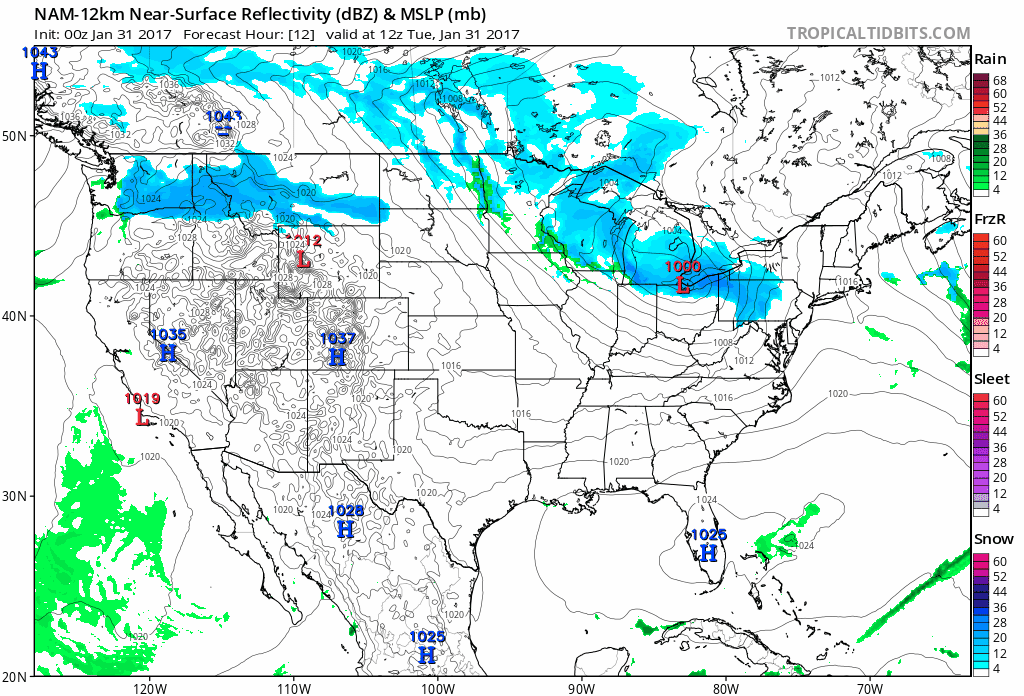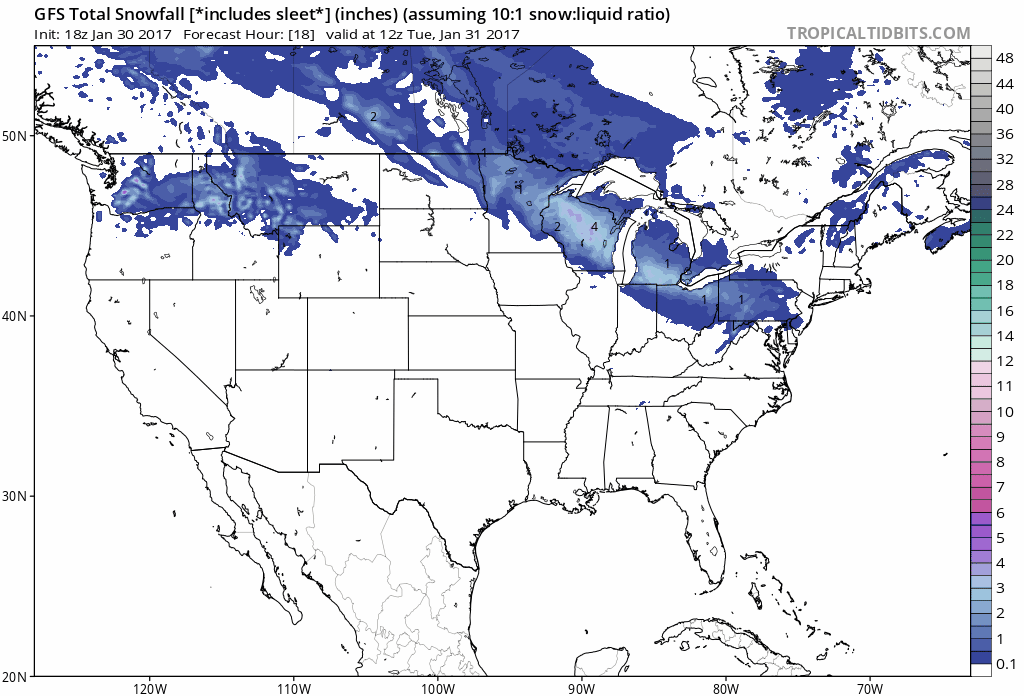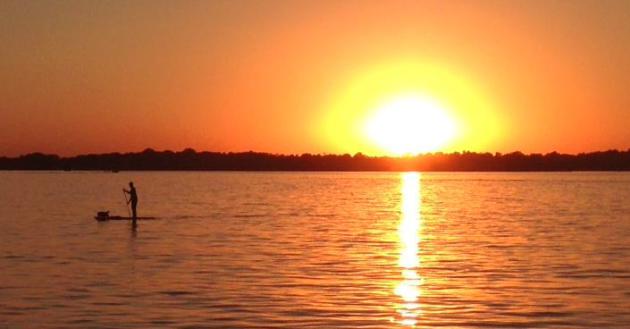23 F. average St. Cloud high on January 30.
39 F. high on January 30, 2016.
January 31, 1893: The temperature drops 40 degrees in five hours during a blizzard at Park Rapids.

Minor Clipping - Models Hint at Mild February
Why do Minnesotans stay put, in spite of challenging winters? A happy marriage of factors, but our lakes are a huge reason.
The 'Land of 10,000 Lakes' really has 11,842 lakes of 10 acres or larger, according to Minnesota's DNR. We have 90,000 miles of shoreline, more than California, Florida and Hawaii combined. Minnesota has one recreational boat for every six people, more than any other state.
You can drive on them in the winter, swim in them in the summer, and admire them year-round.
Minnesota winters have warmed 5.4 F since 1970, according to Climate Central. Will our lakes be able to adapt to continued warming? Stay tuned.
A coating to an inch of snow falls today as a departing clipper whips up colder winds. Temperatures run a few degrees below average as we sail into February, but I don't see any subzero nights for the immediate metro thru mid-February. In fact models are hinting at a mild bias next month. Nothing new there.
Driving back from Brainerd Sunday I was struck by a lack of snow cover. No jolts of southern moisture brewing - the pattern just isn't ripe for significant snows anytime soon. But an inch or 2 may fall next Saturday.

10-Day Snowfall Potential. The time series of accumulated snow (GFS) for the next 10 days shows a fair amount of lake effect snows, as much as 12-24" of new snow from near Boise to Yellowstone National Park. The Sierra and Cascade ranges pick up more snow as another Pacific storm pushes inland. Animation: Tropicaltidbits.com.
Winter Warming Trends in the U.S. A 5.4 F. warming during meteorologist winter since 1970 in the Twin Cities? That's not a climate model; that's based on observations from climate stations positioned well away from the "Urban Heat Island" effect. Climate Central has more details: "...Warmer winters may seem nice at first, but they have major ecological and economic consequences. While warmer weather extends the growing season, it also changes the growing zones while also allowing for the survival of agricultural pests and weeds that normally cannot endure the cold, putting crops more at risk for damage. Warmer winters could also cause some plants to flower earlier, so by the time bees and other pollinators emerge in the spring, their food sources may have already disappeared, causing both bee and plant species to suffer. Winter snowpack, already on the decline, insulates soils for trees, provides water for reservoirs later in the year, and reduces wildfire risk, could disappear if winters continue warming..."
Map credit: "January 21-23, 2017 | 73 confirmed tornadoes, 90 reports, 198 warnings, 14 watches."
Jan. 20 SPC event page | Jan. 21 SPC event page | Jan. 22 SPC event page
NOAA SPC tracks violent EF-4 and EF-5 tornadoes since 1875 here.
Storms Preview Sea-Rise Damage to California Roads, Cities. The Washington Post reports: " Ocean rise already is worsening the floods and high tides sweeping California this stormy winter, climate experts say, and this month’s damage and deaths highlight that even a state known as a global leader in fighting climate change has yet to tackle some of the hardest work of dealing with it. The critical steps yet to come include starting to decide which low-lying cities, airports and highways, along with threatened landmarks like San Francisco’s Embarcadero, to hoist above the rising water and which to abandon — and where to start getting the many billions of dollars for those climate rescues. “People always tell us we’re ahead of the curve” on climate change, said Larry Goldzband, head of a regional San Francisco Bay commission that late last year stepped up regional efforts to identify and prioritize communities and infrastructure at risk from rising sea level. As proud as Californians are of their climate-change efforts, “I always think, ‘Man, if we are ahead of the curve, I feel sorry for the rest of the country,’” Goldzband said..."
Photo credit: "This Jan. 14, 2017 photo provided by Fraser Shilling shows flooding along Highway 37 near Vallejo, Calif. Ocean rise already is worsening the floods and high tides sweeping California this stormy winter, climate experts say, and this month’s damage and deaths highlight that even a state known as a global leader in fighting climate change has yet to tackle some of the hardest work of dealing with it." (Fraser Shilling via AP) (Associated Press)
Extreme Weather is Becoming More Frequent - and Expensive - in Europe. Here's an excerpt from Pacific Standard: " ...This week, the European Environment Agency released its latest report,
which clearly spells out the threat of rising sea levels and more
extreme weather, such as more frequent and more intense heatwaves,
flooding, droughts, and storms due to climate change. The report — updated every four years — says more flexible adaptation strategies are crucial to mitigating these effects. Climate-related
extreme events in EEA member countries have accounted for more than 400
billion euros in economic losses since 1980, according to the report.
One of the important new findings in the report is that there was no
global warming pause between 1998 and 2012, as had been suggested by
some temperature record evaluations later shown to be flawed...."
Photo credit: "A high tide combined with a storm surge floods the Menai Straits." Credit: Adrian Kingsley-Hughes/flickr
Tesla Gives the California Power Grid a Battery Boost. Here's a clip from The New York Times: "Just off a freeway in Southern California, 396 refrigerator-size stacks of Tesla batteries, encased in white metal, have been hastily erected with a new mission: to suck up electricity from the grid during the day and feed it back into the system as needed, especially in the evening. The installation, capable of powering roughly 15,000 homes over four hours, is part of an emergency response to projected energy shortages stemming from a huge leak at a natural gas storage facility. The project, which officially comes online on Monday, is an important and surprising demonstration of how utilities can use enormous collections of batteries in place of conventional power plants..."
Photo credit: "Tesla battery packs at Southern California Edison’s Mira Loma substation." Credit Tesla.
Photo credit: "Warren Buffett, chairman and CEO of Berkshire Hathaway, speaks while Bill Gates looks on at Columbia University in New York, U.S., January 27, 2017." REUTERS/Shannon Stapleton.
Illustration credit: "We talked to industry insiders and tracked the trends to identify the tech that will make the biggest impact in 2017." Illustration: Jason Schneider.
Photo credit: "Sun peers through onto Playa del Amor in Marieta Islands, Mexico." Photograph by Miguel Naranjo.

Photo credit: "Bill Parcells gets a Gatorade shower after a victory." AP.
TODAY: Coating - 1" of flurries. Winds: NW 10-15. High: 34
TUESDAY NIGHT: Flurries taper. Low: 18
WEDNESDAY: More clouds than sun, brisk. Winds: NW 10-15. High: 21
THURSDAY: Chilly, at least the sun is out. Winds: W 10-15. Wake-up: 7. High: 19
FRIDAY: Partly sunny, no travel hassles. Winds: NW 8-13. Wake-up: 4. High: 21
SATURDAY: Couple inches of snow possible. Winds: SE 8-13. Wake-up: 10. High: 28
SUNDAY: Sun returns, a better travel day. Winds: NW 10-15. Wake-up: 17. High: 27
MONDAY: Intervals of sun, relatively mild. Winds: E 5-10. Wake-up: 18. High: 32
Climate Stories...
Photo credit: "The 7-mile-wide crater left on top of Mount Tambora in Indonesia after its volcanic eruption in 1815." (Iwan Setiyawan/AP Photo/KOMPAS)
Wisconsin Leads on Climate Research, Even As Agencies Cut Science from Websites. Here's an excerpt from Midwest Energy News: "...With an
economy heavily dependent on agriculture, outdoors tourism and
forestry, climate change could have a range of severe impacts, as WICCI has documented. The
trout fisheries that bring anglers from around the country could be
seriously affected by warming waters and changing stream flows.
Increased heavy rains could cause soil erosion devastating to farms and
dairies. Warmer weather could affect wildlife and the spread of
tick-born Lyme disease, a serious problem in a state famed for hunting
and camping. Groundwater crucial for
agriculture and streams in the Central Sands area could be reduced, and
political tension between different groundwater-using interests could
grow. Increasing heavy storms could wreak havoc on towns and fishing
operators on the coast of Lake Michigan..."
Wisconsin DNR Blatantly Ignores Climate Change Science. Here's an excerpt of an Op-Ed at USA TODAY: "...Currently,
a few federal, and more state and municipal governments, as well as a
great many businesses in the private sector are planning strategies for
dealing with the impacts of climate change. Those impacts — which
include rising sea levels, increased prolonged periods of excessively
high temperatures, more wildfires, more severe droughts, more severe
storms, permafrost thawing, and ocean acidification — are already
significantly affecting our communities, ecosystems, economies and
public health in negative ways. We should be outraged when an agency
that works for and is paid for by the people of Wisconsin blatantly
chooses to ignore information that clearly establishes human activity as
the primary cause of climate change, a fact that must be addressed if
our children and grandchildren are to have an environment that is even
close to that which we have enjoyed. We expect our doctors to use the
very best in scientific knowledge to help us when we get sick — not just
in treating our symptoms, but in addressing the underlying causes..."
In America's Heartland, Discussing Climate Change Without Saying "Climate Change". I
have talked to farmers from Michigan to Minnesota, Iowa and South
Dakota, and to a person they come up after my presentation to privately
tell me about the changes they've witnessed on their farms. They may not
call it climate change, but they know the climate has changed - they
are on the front lines. Here's an excerpt of an excellent piece at The New York Times: "...No-till
farming addresses a dire problem facing American farmers: Almost 1.7
billion tons of topsoil are blown or washed off croplands a year, according to
the Department of Agriculture, resulting in billions of dollars in
losses for farmers. Keeping the soil healthy and covered also reduces
evaporation by 80 percent, helping farmers conserve water, the
department estimates. Farmers like Mr. Palen also happen to be
protecting a vast and valuable carbon sink, making him an ally to
climate-change campaigners. The soil traps far more carbon in its depths
than all plant and animal life on the earth’s surface, scientists
estimate. A 2013 study
estimated that no-till and other restorative farming methods could
achieve up to 15 percent of the total carbon reduction needed to
stabilize the climate..."
Photo credit: Omar Bustamante, FUSION.
Image credit: "The background image of Earth was obtained by NASA's Earth Polychromatic Imaging Camera aboard NOAA's Deep Space Climate Observatory. (Credit: NASA. http://epic.gsfc.nasa.gov). The curves are the time series of the dissipation of the total kinetic energy, which is used to measure the efficiency of the global atmosphere as a heat engine during the modern satellite era (1979-2013)." University of Houston.
No comments:
Post a Comment